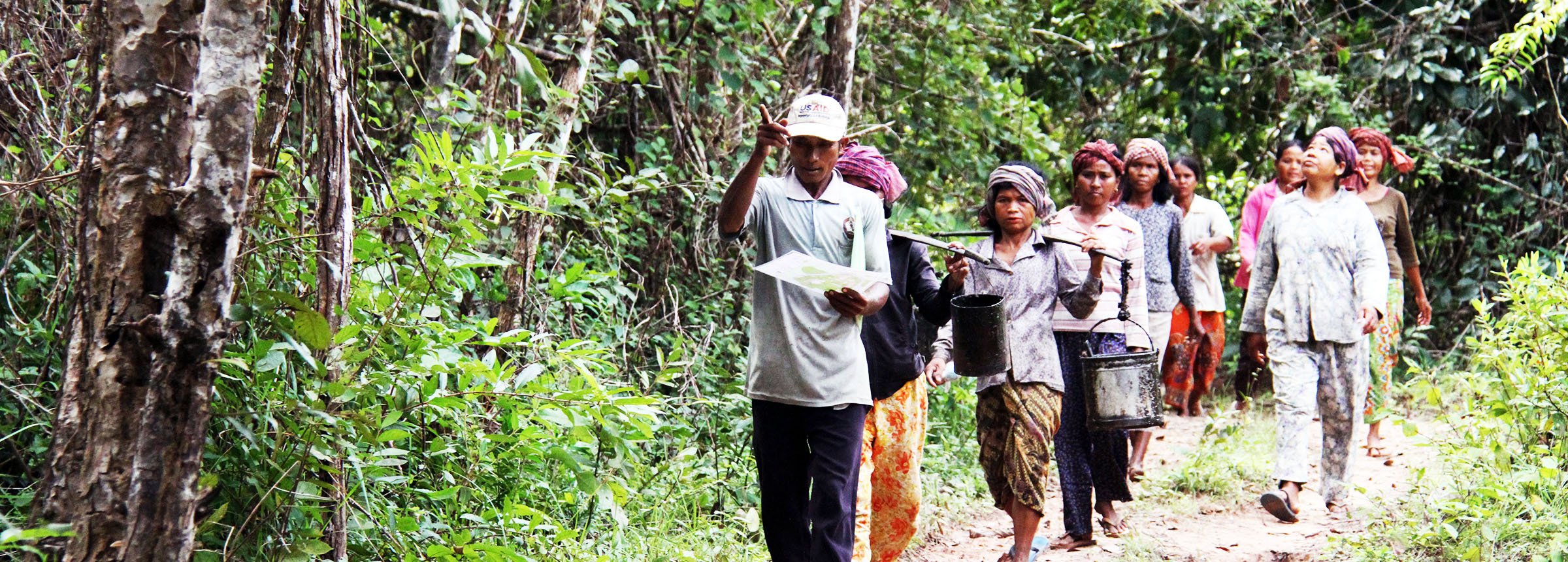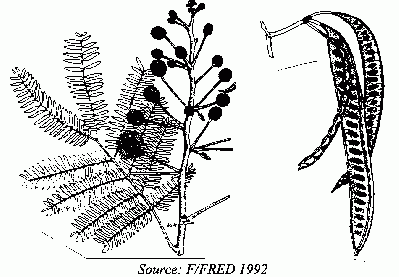
Leucaena leucocephala – a versatile nitrogen fixing tree
FACT 97-06, September 1997
A quick guide to multipurpose trees from around the world
Among about 700 trees now known to fix nitrogen, none are more versatile than Leucaena leucocephala. This lowland tropical American legume circled the globe four centuries ago. In Latin America it served as a food source (beans). Now it serves worldwide as a source of fuelwood and charcoal, pulp for paper and rayon, leaves for fodder and green manure, timber for building and furniture and poles and crafts, shade for trees like coffee and cacao, seeds for crafts, and gum for glues.
 Botany
Botany
Leucaena leucocephala (Lam.) de Wit has a history of several botanical names, including L. glauca and L. latisiliqua. It was widespread in Mexico and Central America at the time of arrival of Spaniards in 1520, and by the end of the century had traveled in their galleons to the Philippines. From there it spread worldwide as shade for coffee and as fuelwood and fodder tree. Only one variety occurred worldwide prior to the 1950’s, the ‘common’ shrubby, seedy type in the subsp. leucocephala. Gross misnomers exist and only add confusion; e.g., the ‘Hawaiian’ type is not from Hawaii, the ‘Peru’ type is not from Peru, the ‘Salvador’ type is not from El Salvador.
The species varies widely from small shrubs to handsome trees (to 20 m and 40 cm dbh). Leaves are 15 to 20 cm long and bipinnately compound. Flowers are white and in compact heads of about 150 flowers. It is fully self-fertile and rarely outcrosses, making it very seedy with 4-10 pods per head. The brown pods hang vertically, with about 15 seeds per pod. There are 10,000-20,000 seeds per kilogram.
Few countries lack a special name for this species and its relatives. ‘Guaje’ (Spanish) and ‘huaxin’ (Zapotec) are basis for the name of the State of Oaxaca, Mexico, near its origin. Other names include ‘koa haole’ (Hawaii), ‘tangantangan’ (Pacific isles), ‘ipilipil’ (Philippines), ‘lamtoro’ (Indonesia), ‘yin hue whan’ (China), ‘subabul’ or ‘kubabul’ (India), and ‘leucaena’ (international) are among the better known.
Ecology
Leucaena probably originated in calcareous lowland soils of the Yucatan peninsula (17 N) of Mexico and Guatemala. It thrives on limestone rich soils (including highly alkaline soils) and fails where pH is under 5, especially if aluminum saturation is high. Mild frosts kill back the tree, but regrowth is adequate for commercial fodder production in south Texas, USA and Queensland, Australia. Cool temperatures greatly slow leucaena’s growth, and it is not a competitive legume for mid-elevations (above 1000 m) in Mexico, Hawaii, Nepal or East Africa, regions where L. pallida and the KX2 hybrids excel. Leucaenas are highly drought-tolerant once established, and naturalize under rainfalls ranging from 500 to 2000 mm. They do not stand waterlogging and are replaced by Prosopis spp. in extremely arid areas. Nodulation and N-fixation can involve many types of Rhizobium, and P uptake depends entirely on activity of a wide range of VAM (vesicular arbuscular mycorrhizae).
Establishment
On most eroded tropical soils, leucaena establishment is greatly accelerated by addition of phosphorus and calcium. Seeds have a hard coat that must be scarified to permit water absorption by nicking the seed coat or soaking 3 minutes in boiling water or 15 minutes in sulfuric acid. Direct seeding requires good moisture and weed control conditions. Nursery-grown seedlings thrive in 15-cm long dibble-tubes with aerial root pruning. They transplant well in three months, after at least a month in full sunlight. Bareroot transplants have also been used. Cloning has no direct interest in the highly self-fertile L. leucocephala, and is difficult at best. Weed control is essential during establishment and seedlings need protection from grazing animals.
Uses
Wood. ‘Instant Forests’ occur when leucaenas are transplanted well, with canopy closure in 3 months. They can grow to a mature height of 13 to 18 m in 3 to 5 years. Mean annual wood increments range from 20 to 60 m3 when population densities are high (over 5000/ha). Isolated trees can achieve dbh of 50 cm. The wood of 5-yr-old trees has specific gravity of about .52 and 46% moisture, and has a brown heartwood that reddens with age. It serves well for posts and parquet flooring, and can be used for furniture and lumber. The wood is a preferred fuelwood internationally, burning slowly with little ash or smoke, and makes an excellent quality charcoal. Varieties like K636 have erect boles more suitable for timber production, which can be enhanced by close spacing and pruning.
Fodder. Foliage of L. leucocephala has one of the highest digestibilities (60 to 70%) for ruminant animals among tropical legumes and grasses. All animals relish the foliage. Annual forage yields are very high under good management, ranging over 20 t dry matter/ha with 3-month harvest at population densities exceeding 50,000/ha. Cattle and goats make superior gains on grass supplemented with 20 to 30% leucaena. Range grazing is the most economic management, with leucaenas in rows spaced 5-8 m and grass between. Mimosine and DHP are problems overcome by ruminant bacteria (see “problems” below). Non-ruminant animals are more seriously affected by these compounds. However, leucaena is used up to 5% in poultry rations to color egg yolks.
Green manure. ‘Growing Your Own Nitrogen’ is a motto that deserves wide application in the tropics, as soils become increasingly eroded and impoverished. Leaf litter yields from solid plantings of leucaenas exceed 10t/ha (dry) with up to 300 kg N/ha. For alley cropping, it is planted in hedgerows and coppiced at 50 to 100 cm.
Other products. In Southeast Asia, tender vegetative shoots of leucaena are eaten, and seeds are made into tempeh (see “problems” below). Both seeds and leaves have high protein (25%) and Vitamin A precursors (400 ppm). Gums in its leaflets complicate the production of liquid protein extracts, a potentially valuable product. Exuded leucaena bark gum is an excellent substitute for gum arabic, with local use in Asia.
Genetic improvement
Leucaena leucocephala is a polyploid with 2n=104 chromosomes, probably arising as a hybrid among two of the many diploid species in the genus. Collections grown in Hawaii have revealed many outstanding varieties of L. leucocephala, including K584 and K636, to supplement earlier releases such as K8, K28 and K67. One new hybrid population (LxL) exploits intraspecific heterosis. However, the genus Leucaena is an interbreeding complex that permits improvement of L. leucocephala from any other species. Fertile hybrids occur from crosses with other polyploid species, including L. pallida (2n=104), L. diversifolia (2n=104) and L. confertiflora (2n=112). Among these, populations KX2 and KX3 were bred by recurrent selection in Hawaii and often lead international fodder yield trials. Leucaena leucocephala can also be crossed to diploid species to make fertile hybrids (e.g., L. pulverulenta, 2n=56) or seedless hybrids (e.g., L. esculenta, 2n=52). The seediness of self-fertile leucaenas is an issue of concern in a few places in the tropics (such as Hawaii), where feral animals do not exist. Seedless hybrids offer an attractive option to plantations in these areas. Seedless plantations can also be achieved by cloning any of the self-sterile leucaenas, including segregants from KX2. Since varieties of L. leucocephala are all self-pollinated, seed sources are few (e.g., Hawaii Agricultural Research Center) and local seed orchards are recommended.
Problems
Two problems of leucaenas dominate literature, although damage by people and animals are more important. An historic problem is that of the amino acid, mimosine, found in L. leucocephala around 4% dry weight in leaflets and seeds. Mimosine degrades to form DHPs (dihydroxypyridines) that are depilatory and goiterogenic. These are degraded in the rumen of ruminants by a bacterium, Synergistes jonesii. Such bacteria are associated only with leucaenas, thus not generally found in temperate animals, and must then be added. Mimosine also degrades due to heat and precipitates with iron salts.
The psyllid, or jumping plant louse, attracted great attention as it circumnavigated the globe between 1984 and mid-1990’s. Long known throughout the Americas, Heteropsylla cubana Crawford can defoliate leucaenas seriously when there are no predators around. However, in Hawaii, and in most countries where it has moved, the psyllid now is under heavy predation or parasitization. It causes a problem largely where leucaenas are regularly lopped or browsed for foliage, providing a rich continuing resource of the juvenile leaflets needed by the psyllid. Useful predators that have been deployed abroad include the beetle Curinus coeruleus and a parasitic wasp. Breeding in Hawaii revealed rich genetic resources of resistance, now available in varieties like KX2. Within the species L. leucocephala, however, the best tolerance (e.g. K636, K584) is inadequate to prevent yield loss under forage management unless predation is heavy. Once established, leucaena trees do not appear to suffer yield loss due to psyllids.
Other challenges to scientists include leucaena’s susceptibility to leafspot disease in South America, to rootrots caused by Phytophthora drechsleri and Fusarium semitectum in wet soils, and to aluminum toxicity in acid soils.
Resources
A Leucaena Network (LEUCNET) was established in 1994 to link scientists working with leucaenas, coordinated by the University of Queensland, University of Hawaii and Oxford University. A newsletter is published regularly, and seed sources for research listed. Contact FACT Net for more information.
Principal references
Brewbaker, J.L. 1987. Leucaena: a multipurpose tree genus for tropical agroforestry. In Agroforestry: A Decade of Development, H.A. Steppler and P. K. R. Nair (eds). ICRAF, Nairobi, Kenya. pp. 289-323.
Hughes, C. (In press) Monograph of Leucaena (Leguminosae-Mimosoideae). Vol. 20, Systematic Botany Monographs, Amer. Soc. Plant Taxonomist, Ann Arbor, Michigan.
NRC. 1984. Leucaena: Promising Forage and Tree Crop for the Tropics. 2nd ed. U.S. National Research Council. USNAS, Washington, D.C.
Shelton, H.M. and J.L. Brewbaker. 1994. Leucaena leucocephala – the most widely used forage tree legume. In Forage Tree Legumes in Tropical Agriculture, R.C. Gutteridge and H.M. Shelton, eds. CAB International, London, Chap. 2.1, pp. 15-29.
Shelton, H.M., C.M. Piggin and J.L. Brewbaker (eds). 1995. Leucaena – Opportunities and Limitations. ACIAR Proceedings 57, Canberra. (Proc. of workshop held in Bogar, Indonesia, 24-29 Jan. 1994).
Sorensson, C.T. and J.L. Brewbaker. 1994. Interspecific compatibility among 15 Leucaena species via artificial hybridizations. Amer. J. Bot. 81:240-247.
Written by Dr. J.L. Brewbaker, Univ. of Hawaii, Dept. of Horticulture, 3190 Maile Way, Honolulu, HI 96822 USA
A publication of the Forest, Farm, and Community Tree Network (FACT Net)
